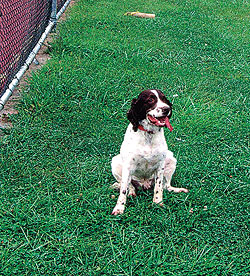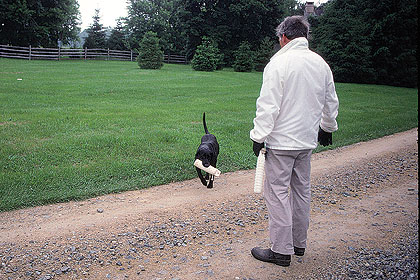Drilling is repetitious, so provide pup with fun.
By John McGonigle
 The author uses the fence (in this case, a tennis court) at a neighboring park to teach lining drills. Note dummy on ground. |
In a perfect world your gun dog would see every shot bird fall because he would have flushed it in range for you prior to the shot.
Suffice it to say our hunting jaunts are never perfect, thus the need to sometimes direct our dog to a fallen bird he did not see go down; a blind fall, in other words.
Let me be straight up front; I believe in the KISS method in most things, KISS meaning Keep It Simple, Sam. Simple is all we need to train a good gun dog to retrieve birds he did not see fall.
Several years ago I did a story about a Labrador retriever that, while he did not win the National Amateur Championship Field Trial, did finish it. What a wonderful, fantastic dog he was. After watching him perform at length in the field and water I decided that anything he could not do was unnecessary.
The dog's owner supplied cold drinks from his kitchen after we finished in the field, but I have little doubt he could have just as easily sent his Lab to retrieve the drinks -- the dog was that good.
Lining drills are meant to teach pup to follow an imaginary line, or path, that you point out until he finds a bird. Field trial folks that run Labs do myriad lining drills at great length, both figuratively and literally.
One drill uses imaginary lines that would extend forever from the spokes on an imaginary wagon wheel. Pup is seated at the hub of the wheel, given an imaginary line and cast (directed) off to follow the line until he finds a bird. This level of training is way over my head, and is not really within the realm of most spaniels.
I mention the difficult drill to inform readers of the exacting directions that field trialers use when training retrievers, and to inform readers that such small delineations in direction can and are learned by successful field trial competitors. Also, however, I write it to assure hunters that such training extremes are unnecessary for gun dogs, even very good performers.
Start Young
Pup can be quite young when you start him on hand signals for blind retrieves. When pup is retrieving pretty reliably you can work blind retrieves (blinds) into his training sessions with good results.
Start by teaching pup to go "back" in the direction he and you have just come from when leaving the training field or yard. If you have room, a fenced yard makes a good area to teach pup to take hand signals, or "lines," to a fallen bird. Start in little to no cover until pup is ready to progress.
Walk pup at heel (on or off lead, as necessary) and drop either a dead pigeon or a training dummy, making sure pup sees it as you continue walking for about 15 yards. Command pup to hup or sit and step in front of him as he continues facing away from the bird or dummy.
Unclip pup's lead if necessary. Pause and then quickly raise your right hand high above your head and slightly forward, palm towards pup, and crisply (but not too loudly) command "Back."
Pup will almost certainly race back the 15 yards and pick up the dummy and retrieve it to you. You will naturally encourage him to be quick by commanding "Come" just as he grabs the dummy. Stooping down to his level and extending your hand encourages his quick return even more.
Repeat this at least four times a week for two or three weeks and extend his "back" retrieve to 20 yards, and then extend the distance as pup progresses. Eventually the distance to the bird should be 75 to 100 yards.
After three weeks of the "back" drill, start pup taking lines "over," or to one side of the other.
Start, if possible, by hupping or seating pup with his back against a fence while you stand facing him from about 10 yards away. Toss a dummy or dead bird so it lands on the ground alongside the fence about 10 yards from pup; make pup remain seated until released.
Once pup has shown control, command "Over" and at the same time step to the side the bird was thrown and point your arm and hand straight out from your body in the same direction. If pup is keen, he will race to the bird, grab it and return it to you with haste.
 The author's friend starts each training day with "baseball diamond" drills on the lawn for his Labs. |
Be sure to command "Come" as he picks the bird up and then stoop down to receive the bird as he approaches. Both little tricks will encourage pup to hurry to you with the bird.
An enthusiastic retrieve is a good ending for a well shot game bird; it is the icing on the proverbial cake.
Teach pup to retrieve from both sides (directions) and be sure to show pup clear hand and arm signals while also stepping to the side of the retrieve while saying "Over." After two or three weeks alternate the side to which you throw the bird. Afterwards place dummies at each base and send pup to them.
After five weeks or so Pup should have mastered "Back" and "Over," but now we will introduce another drill to assist him with the same concepts.
Play Ball €¦ Daily
We will use the traditional baseball diamond as utilized for years by retriever field trialers. No fence is needed for the drill and it can be accomplished nearly anywhere.
I have a friend who was a very successful field trialer for years who did the baseball drill every morning with all of his dogs before doing any other lessons. He considered it basic and he felt doing the drill regularly helped him and his dogs be successful. It is difficult to argue with concentrating on the basics, or with success.
Make pup sit and remain at the spot we will consider to be the pitcher's mound on an imaginary baseball diamond. Place a dummy or dead bird at what would be first, second and third base wh
ile pup watches. Distances for the "diamond" should be modest.
Walk to pup and pet him briefly without saying anything so pup knows you are pleased with him. Don't excite him so much he moves off the "mound."
Now stand at "home plate" facing pup on the "mound." Step to your right, raising your right hand and arm to point to your right while saying "Over." If you locked the earlier drill into pup's psyche he should race to first base and retrieve the dummy to you. Give pup a "Back" to send him to second base and when it is completed, command "Over" and send pup to third.
If pup becomes confused and retrieves the wrong dummy, do not despair. Instead, back up and only place one bird or dummy at first base, and then send pup only to first base.
Then place a dummy on third and send pup only to third. Finally, place a dummy on second and send pup for it. If pup is well bred he will pick the drill up quickly. Work until you can fill all three bases with birds or dummies and have pup retrieve them as directed.
This really is an excellent drill to start your training day with because it puts pup on notice that, while the time together will be fun, you are in charge and he must obey commands to continue the fun.
In several months pup will take hand signals during your drills, but more importantly, he will be able to follow them in the field to find and retrieve birds he did not see go down.
Do not be concerned if initially pup does not get the hang of finding unseen birds as quickly as you would like. Provide pup with drills and remain patient, and he will follow your "over", sit on command and then take a "back" to a fallen bird.
Using hand signals for blind retrieves is not rocket science, and by using the KISS method, we will recover more birds.






